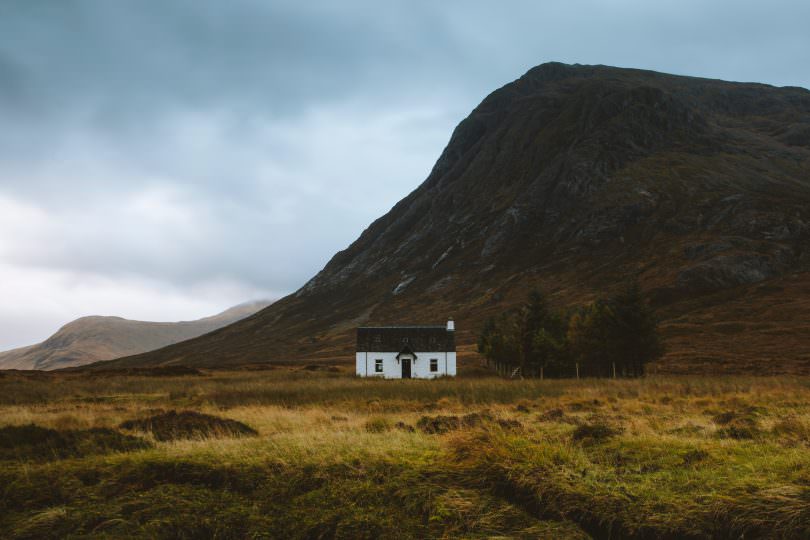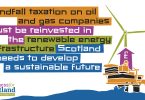Since 2015 I’ve been developing a model of Annual Ground Rent called AGFRR (Annual Ground, Floor, Roof Rent). It’s simple and has the potential to replace all existing UK, Scottish and local taxation, provide a Universal Citizens’ Income of around £200 per week and give all of the people of Scotland a financial stake in our nation. It would substantially increase public expenditure for reconstruction and reduce the burden of taxation on almost all personal and business taxpayers.
The simplicity lies in the arithmetic, which requires no fancy actuarial calculations or guesstimates of income or corporation tax receipts or consumption taxes such as VAT. Using AGFRR, government calculates its budget at the start of a year then it divides the budget amount by the square meterage of the country.
I address ability to pay and there is then an adjustment for a rate per square metre according to four land types.
Example of AGFRR for the budget of an independent Scotland
- Public Expenditure by Scottish and local government and agencies per GERs 2018/19 – £43,198,000,000
- Add ten per cent to increase public services and infrastructure – 4,319,800,000
- Add estimated share of reserved UK public expenditure per GERs 2018/19 – 32,140,000,000
- Add cost of Universal Citizens’ Income of £10,000 for every Scottish resident including children – 55,000,000,000
- Total public expenditure by Scottish and local government and agencies – £134,657,800,000
I’ve used four land types to illustrate, but you could have as many variations as parliament decides. I show the AGFRR take as a percentage of the total.
| Land types | % of Scotland’s land mass | area of Scotland’s land mass in m2 | rate per m2 in £ | share of AGFRR | £ |
| Woodland | 15.85% | 13,440,000,000 | 0.05 | 0.50% | 672,000,000 |
| Arable | 6.46% | 5,480,000,000 | 0.05 | 0.20% | 274,000,000 |
| Rough grazing | 61.61% | 52,260,000,000 | 0.015 | 0.63% | 844,000,000 |
| Urban and buildings | 8.04% X 2: 16.08% | 13,640,000,000 | 9.74 | 98.67% | 132,853,600,000 |
| TOTAL | 100% | 84,820,000,000 | 100% | 134,657,800,000 |
Note: as most properties have more than one storey, the urban and buildings land type is doubled to show the relevant area charged.
Illustration of AGFRR on certain land types with no reliefs or exemptions
| Property | AGFRR payable |
| Small flat in 3 storey tenement & share of common areas | £930 |
| Single fronted shop in 4 storey tenement & share of common areas | £686 |
| 3 bedroom semi detached villa | £4,285 |
| Secondary school with two sports pitches | £430,000 |
| Premier football stadium of pitch, four stands with covered training pitch and car-parking | £684,255 |
| Bowling club with two greens and clubhouse | £49,415 |
| 400 acre arable farm with farmhouse and agricultural buildings | £84,893 |
| 8 storey city office/hotel block | £344,000 |
| 100 acre rough grazing farm with farmhouse and agricultural buildings | £8,000 |
| 45,000 acre estate mostly rough grazing with some woodland, castle and outbuildings | £8,468,000 |
All public and private owners of land will be liable to pay AGFRR. The source of all these untapped funds is land and property unused or not stewarded for generations. Parliament would decide which reliefs (if any) should be given for educational, social, sporting or charitable facilities.
AGFRR has particular relevance now; while government steels itself to wonder how the UK will pay for public spending, AGFRR provides the source of the cash without borrowing.
Land is constant. It can’t be taken off shore. The Land Register of Scotland and General Register of Sasines ensure AGFRR can’t be avoided. A property owner can calculate and Revenue Scotland can collect with ease. Miscalculation by a land owner is regulated by everyone’s return being public and algorithmic spot checks. Failure to pay over three years empowers the Revenue Scotland to repossess the land.
Landlords are responsible to pay AGFRR to Revenue Scotland but can reclaim it from their urban tenants or half from their agricultural tenants.
Almost all the key elements to introduce AGFRR are in place: Revenue Scotland; the Land Register of Scotland with its cadastral plan and the General Register of Sasines. All that’s missing is an AGFRR website so owners can go online to calculate their liability, make their return and pay AGFRR over ten months. There is no new technology involved.
As AGFRR can provide the funds for an annual Universal Citizens’ Income of around £10,000 for all men, women and children no one is left behind, and to cement that inclusiveness up to ten per cent of everyone’s UCI could be invested in the Scottish Investment Bank so that we all have a financial stake in our economy, while entrepreneurs have at least £5.5 billion of Scottish money each year to borrow.
AGFRR can be introduced now under section 80l of the Scotland Act 1998 without HMRC’s consent, but its real benefit lies with independence.
Look at the effect of AGFRR on a person on average annual earnings of £26,500 living alone in a 3 bedroomed villa. The first column (Devolution without AGFRR) illustrates his income and outgoings under the existing UK and Scottish taxation systems. The middle column (Devolution with AGFRR) illustrates his financial position if AGFRR is introduced under Devolution. The third column “Independence with AGFRR) illustrates his financial position if AGFRR is introduced in an independent Scotland to replace all existing UK and Scottish taxes.
| Income or (tax deduction) | Devolution without AGFRR | Devolution with AGFRR | Independence with AGFRR |
| gross salary | £26,500 | £26,500 | £26,500 |
| ADD: Universal Citizens Income | £0 | £10,000 | £10,000 |
| TOTAL INCOME BEFORE ALL TAX AND/OR AGFRR HAS BEEN CHARGED | £26,500 | £36,500 | £36,500 |
| LESS: (Income tax and National Insurance) | (£4,000) | (£2,144) | £0 |
| LESS:(Vat and other consumer taxes) | (£4,900) | (£4,900) | £0 |
| LESS:(Council Tax and Water Rates) | (2,400) | £0 | £0 |
| LESS: (AGFRR on 3 bedroomed semi detached villa) | £0 | (£3,262) | (£4,285) |
| NET INCOME AFTER ALL TAX AND/OR AGFRR HAVE BEEN PAID | £15,200 | £26,194 | £32,215 |
Britain is broken, let’s escape Westminster’s old ways, redesign our tax system and we could use AGFRR to boost the nation’s prosperity.
Further reading: https://annualgroundrent.scot









Think you need to.take advice on the rural stuff. The values are unachievable.
Even the best arable land cannot generate a net margin of £500/ha which is the land tax payable. As for the £150/ha for rough grazing..oooft! Nae chance.
As stated earlier it is more than double total income from farming so is not thought out properly.
On my own farm I would pay £35,000/or which is 30k more than my profit even with subsidies!
The forestry one also….how do I fund a land tax when I only get an income once every 30 years ? Not exactly encouraging planting of trees !!
Good idea in principle but needs work or it will get laughed out the building as impractical and unachievable.
Hi Graeme
Have you put this idea to the Social Justice and Fairness Commission? They are having a series of consultations this week about Universal Basic Income. Will you be taking part?
How many Scottish Bowling clubs can pay £1000 a week tax? Ours needs to get grants just to get equipment and make ends meet!
How can land like roughly woodland, that produces no revenues, be taxed as though it has an income? It’s a liability to keep woodland in good nick keep trees off roads, thin and replant.
I love this in theory. It makes so much sense. Too much sense so I’m trying to sanity check it. Just to be clear I love the concept and accept there will be winners and losers and I might be a loser. Could be a price worth paying for so many other gains as a country.
Is the £ per sq m then weighted in any way.
e.g My business leases a 250 sq m retail unit in Glasgow City centre. So would my Ltd company therefore pay approx £2,500 a year in land tax. (I currently pay about £55,000 in commercial rates.) Would someone renting the same size of unit in a deprived housing estate pay the same tax?
I currently pay myself in dividends for all the usual reasons. The need to do that would disappear I assume. (I see unemployed tax advisors! The silver linings keep coming….)
If I have a business making a few million a year in profit now at 20% corporation tax I would pay £600,000 in tax. But as the total Floor metres of my business is about 1300 sq m’s I would then pay £13,000 in tax. (
Let’s say the sq m of my garden at home is about 200 sq m. Is that then approx £2,000 per year? But my neighbour has a wee bungalow on 3 times the garden so they would pay £6,000?
If I sell my house and move into a small batchelor pad in the city centre then it goes down to about £,1000 a year? I run by business from home, no Tax on profits?
Surely a huge chunk of unused land would be government owned? Is this lost income unless they can sell it or rent it?
I get the logic of there can’t be tax avoidance issues if there is no other tax? You can’t hide land or buildings.
Every calculation I do is a huge saving, someone must be losing?
My head is about to explode at the implications and benefits but who loses? Especially who out of the worst off loses?
Hi Adam,
The only weighting in my model is the land type on which your land is situated. Otherwise everyine pays the same per square metre.
As your retail unit has a roof, you’ll pay the emterage of the roof too. So if the building is self contained and not part of a larger development with common parts I reckon your Landlord would pay AGFRR of around £5,000 which it could recover from you as tenant.
It would be open to policy makers to set rates in different areas. Given the unknowns post Pandemic the previous valuations of hot areas like city centres might not be so much higher than less popular areas in future.
I reckon over 95% of land/property owners would make savings These will vary enormously but they will still be winners.
The reasons why I embareked on thsi exercise was not just to prove Scotland can raise all the funds it needs for public services from our land but also to get us over the Independence finishing line next time. To achieve that put money in people’s pockets, both the Have-nots and the Haves.
We need to really give our entrpreneurs a huge boost to develop business in Scotland. AGFRR does that.
Equally we need to use the revenue we can source through AGFRR to promote democratic ownership by allocating a £1000 per annum from everyone’s Universal Citizen’s income for investment in our economy. Within a generation everyone has the opportunity to have a substantial financial pot.
No doubt politicans will wish to review the effects of AGFRR down the line post Independence.
The losers are people with big houses and gardens or dilapidated commercial property with modest incomes, big rural landowners who don’t or can’t steward their land to cover the cost of the AGFRR and the public sector which has sat on land and property for generations allowing it to become dilapidated with no benefit to the public purse or its neighbours.
But these potential losers don’t have to be if they use their property productively or sell or give it up to others who will do so. There are plenty of people who would love the opportunity to own and/or develop property either alone or as part of a business or a community and make a commercial and/or social and environmental return on it.
I really like this idea, it would be a great start for an independent Scotland. However for us to have a sustainable future it should proceed in tandem with other measures.
1 – Environmental sustainability. Different uses for land should be taxed at different rates. Genuine rewilding and reforestation should be tax free. We are going to need all that oxygen produced by trees if we want to survive. And by reforestation I don’t mean planting acres of pine for timber where they all get clearcut after a few years. Animal farming should be heavily taxed. It is an extremely inefficient use of land for food and the gases produced by farmed animals are major contributors to atmospheric pollution. That’s without considering the public health impact of commercially farmed non organic meat. Land used for hemp, which can sustainably provide food, clothing, medicines, building materials, environmentally degradable plastics and packaging, and which also regenerates degraded land should be tax free or subject to special treatment. Grouse moors, hunting estates and the like should be rewilded or punitively taxed.
2 – Integrity in public life. At the moment the PM or any Westminster MP can lie through their teeth in Parliament and the rules of the house forbid anyone from accusing them of lying. This is literally insane, it makes a mockery of our whole system of government. Any form of dishonesty in government should be a criminal offence, punishable by sacking the MP, prohibiting them from any future employment in government or the civil service, swingeing fines, imprisonment or all three. In cases where the economic well being or security of the country have been jeopardised for personal enrichment then this should be classified as treason with the potential death penalty. At the moment a civil servant can help draft legislation benefiting a particular industry at the expense of the country as a whole and then go straight into a well paid job in that industry. This should be illegal and there should be no statute of limitations regarding how far back in time the offence took place.
3 – Integrity of the media. The UK mainstream media are with one or two honourable exceptions nothing more than the propaganda arm of the 1% who really control the UK, mostly owned by tax avoiding billionaires operating from tax havens. The BBC, while not privately owned, is controlled by a clique of ex public school boys who are so terrified of the government reducing its funding that they have turned it into the mouthpiece of the government of the day. It is now impossible to get a job in the BBC (apart from the lower admin kind of job) unless you have the right “connections”. Back in the immediate post WW2 period film makers like Ken Loach worked for the BBC and produced high quality programmes giving honest accounts of the problems faced by ordinary working class people. But these films became so popular that the establishment became alarmed about where this kind of thing may lead and set about changing the class composition of the creative and management levels of the corporation, with the result that the lower orders are now represented by caricatures in Eastenders.
The result of all this is a win for the 1% in that the British public have become misinformed and brainwashed to an extent that even the USSR was unable to achieve. At least the population of the communist countries knew they were being brainwashed and developed a scepticism that could make allowances for the state propaganda. The UK citizens have become so deluded and misinformed that they were talked into voting for a Brexit that anyone with a clue about economics could see was going to be a disaster. That’s without going into the issues around the media promotion of corrupt, dishonest and incompetent chancers like PM Johnson. What to do about this? Well we could start with insisting that all media corporations must be based in this country for tax purposes. This could be followed up by serious fines for lying and forcing the newpapers to print their apologies for their lies on the front pages.
Sorry if I’m going on a bit here but if we are to aim for any kind of sustainable future, or indeed any kind of future at all we have to become aware of what the problems really are. It will take a lot more than solar panels and windfarms. We will have to address fundamental imbalances in our economic and social structures and we will have to start doing it soon. Your ideas here are a great start but we don’t have long. If we don’t start to make any progress on the climate front in the next ten years we will not be able to head off a real climate catastrophe with unimaginable consequences.
Thanks, Pete.
Policy makers could certainly rate diferrent uses of any land and property to reflect their environmental benefit or damage.
As regards your other comments it is important that the society we create has confidence in our institutions and those we entrust to lead and serve us. I think that the UK brand of governance has been so diminished by recent behaviour and revalations of past behaviour that there is a genuine thirst for new transparent ways in Scotland
Graeme I have been supporting this since you gave a talk to Yes Perth City in 2018. Been selling the idea ever since. Obviously politicians would need to think about how the poorer in society pay for the rents charged by property owners to recover their AGR costs. Also the case mentioned above by Andrew who states that this would destroy crofting. I am 100% in favour of this.
There will be benefits for some hassles for others. Same as all tax systems.
Thanks Robert,
I recall the event in the Salutation Hotel fondly.
I don’t think anyone can claim to be an expert on rural living. The AGFRR take on rural land is less than 2% of the total AGFRR take nationally. It is perfectly possible for there to be a number of different rates for various land types, including crofting. Its not just the AGFRR take but how the land is stewarded not just economically but environmentally and socially which matters.
Are there any variations of this proposal in practice anywhere globally?
Thanks Alex,
There are various systems of land valuation taxes and rent in the World but I haven’t come across any like this. It would be great to be world leading! I think because of our population to land type ratio and natural capital we are particularly placed to benefit from this model
This would destroy the crofting system, leaving the land completely barren.
I have no words.
All crofting communities have their own characteristics so I don’t accept that crofting would be destroyed. There is no such land as barren land in Scotland. Every bit has potential . It depends how it is stewarded both indiviudally and communally
I certainly agree that Independence is a wonderful opportunity to redress inequity and Land taxes as outlined are a great idea, however you still need a suite of taxes to prevent evasion. As an example with land tax only, someone could set up a sales address in Scotland and manipulate the input price to ensure there was a high profit in Scotland and a low profit in their manufacturing hub and so escape tax in both jurisdictions. An additional simple option would be to not tax profits and therefore eliminate Corporation Tax as you have suggested but replace it with a Sales Tax at a lower rate, result is a much less complex system and easier for the Tax Authorities to police. Any concern about people being paid in kind can be addressed by using a Fringe Benefits Tax as we have in Australia, this is extremely difficult to evade.
Thanks Kangaroo,
All states have the capacity to tax business which makes profit from its activities in that country. It just that for various reasons they don’t choose to do so.
I’m relaxed about people making profit from their endevours in Scotland even if they don’t spend it on buying a lot of land in Scotland. I’d expect that they would be inclinded to use their profits in reinvesting in Scotland since the return would be better than elsewhere given the tax regime.
To discourage carpet baggers using Scotland as a place of convenience it would be open to Scotland to restrict ownership and/or residence of land and property in Scotland. Many countries like Denmark restrict foreign ownership.
As I have said elsewhere, in the review of the model policy makers would examine how the wealthiest have behaved with their money and their contribution to society.
Tax to be raised from arable and rough grazing land totals £1118 m. Total Income From Farming in 2018 was £672m. So Scottish Farming will have to foot a tax bill of £1118m out of an income of £672m. How is it going to manage that? And that figure of £672m includes EU subsidies. Strip them out ( the author doesn’t appear to have made any provision for them in his Govt expenditure figure) and the Total Income From Farming drops to about £123m. So the Scottish farming industry will be paying nine times more tax than it’s total income. How’s that going to work? More than a little adjustment and revision needed here, I think.
Thanks Kenny,
The purpose of the exercise was to show that Scotland can raise more than enough for public services from the land. Over 98% of the funds raised in the illustration come from urban land types so the sums raised from rural land are marginal in the great scheme of things albeit individual owners in some cases will pay significant sums commensurate with the amount of land they own.
That total farming income is only £672m from Scotland’s arable and rough grazing areas suggest that there is a lot of arable and rough grazing land which is not farmed. My illustration of a 400 acre arable farm attracting AGFRR of £84,893 before any EU or alternative public subsidies , universal citizen’s incomes does not seem overly burdensome. It will be for government policy makers to decide what support an industry requires taking into account how the land owner or user stewards the land. That’s why any direct payments for the EU were left out.
It’s also for policymakers to decide how many land types there should be and the rate charged per square metre for them, so there could be wide variation of the amount charged if there are multiple land types within the rural areas.
Would there be a ceiling put on income that could be earned by an individual in a year then?
£26,500 seems a conservative estimate of income especially for the majority of wealthy citizens that own detached villas in scotland and the rest of the UK.
Totally agree we should have a universal credit system for all citizens and welcome a taxation system that targets ownership of land and property especially given that many outside scotland appear to own a great deal of the land mass.
Thanks, Ann.
There would be no ceiling on earnings in the illustration. All public revenue is raised from AGFRR on the land and property on it.
The £26,500 is just used to illustrate what someone on average earnings might have in his/her pocket if my model was introduced.
How much higher earners would have depends on how much land and property they own and the AGFFR they will pay.
As AGFRR is a property tax income is not charged. Some people with high income but little or no property will save a lot of tax. However the figures illustrate that everyone can be taken out of poverty through AGFRR.
It may be that a future government might wish to introduce taxes on income and consumption depending on how those with wealth behave but that was not the purpose of the exercise. The purpose was to show that there is something meaningful for both the Haves and the Have-nots if the Scottish government introduces it.
See your para “Landlords are responsible to pay AGFRR to Revenue Scotland but can reclaim it from their urban tenants or half from their agricultural tenants.” As someone with a heritage od landlord abuse, I would do away with agricultural tenant’s landlords paying 50%. Such payments are deductable from the business taxation due and also are used as a tool to continue serfdom. Agric. Landoners are not slow in saying to their agric employee tied housing tenant that the election of a non-Tory gov will result in their employer not having enough money to pay for their employment – especially in the day or two before an election. Believe you me, I have seen this approach personnally as a youngster standing beside my Dad on a Sat morning when the pay envolopes are being handed out by the laird. Please stop this servile practice.
Thanks, Ian,
The 50% was suggested to me by an agricultural tenant as reasonable sum.
I appreciate that the experience of agricultural landlord and tenant is fraught , and the consequences of AGFRR on those relationships needs debate and consideration by those involved.
On the face of it land taxation makes sense particularly from the anti-avoidance viewpoint. What I would like to see is a comparison between the current system and a land taxation system. For example consider forestry which is expected to pay £672m per annum under the land tax system. Where will forest owners get this cash from? If I lived in a wee house but owned all the forestry in Scotland I would have to find £672m every year. This probably means I would sell some of my forests. But who would buy if it comes with a huge annual tax bill? A Bill Gates (or similar of extreme wealth) may find their tax bill reducing but I suspect relocating from Seattle to Scotland may not appeal even if we did get the midges under control.
Forests are productive (they grow and remove CO2 from the atmosphere). In a normal year they don’t produce any income from which to pay the tax.
The same can be said for the large estates. So taxes need to be paid from other income the owner has, for example company profits/dividends.
I look forward paying lower taxes from my house but fear that Scotland may look very different and its physical attractiveness would disappear.
Food for thought.
Forestry is tricky…. How about exemption for non commercial forestry that is available for public access. That would encourage low productive grazing that has tax to be converted to wild Co2 capturing forest. (I have an area that could be in this category)
Thanks Torquil.
It would be open to policy makers to decide what, if any, exemption were required.
I would imagine the aim is to break up large tax avoiders estates. It could potentially lead to the democratisation of land ownership.Perhaps even ordinary people could own a small patch of woodland like Scandinavian hutting culture.
Thanks, Allan
As well as encouraging the breakup of large estates AGFRR also achieves the result without public funds being required to buy the land.
Thanks Alan,
Commercial forests are being harvested at a great rate in Scotland as anyone who lives near them will testify. They are a valuable crop and the owners are reaping the revenue from the trees they planted. So for these owners the affordability of AGFRR should not be an issue. For those planting new or replacement woodland the AGFRR cost will need to be part of their plan for sowing and harvesting over X number of years. The AGFRR on 100 acres would be about £22,000 per annum. Given the savings many people will enjoy as a resut of AGFRR the possibility of owning a share of woodland becomes a real opportunity so I’d envisage a diversity of owners. As an example, ten individuals could take a share in the 100 acres so the AGFRR for each is only £2000 which is a reasonable and affordable payment given the expected value of the crop when it can be harvested and what the individual saved from not having to pay other forms of taxation.
As regards how our landscape will develop will again be a matter for policymakers to develop. Rewilding and reforesting are two major developments in rural Scotland. Planning for repopulation, hutting and value- added work on site will also affect rural life.
I hope my model can encourage many more people to become owners of land in Scotland, and there are various ways that this can be achieved.
As regards billionaires owning more land then as can be seen from the illustration there si a huge AGFRR price to be paid. It woudl also be possible for the Scottish parliament to restrict ownership by foreigners as many countries do.
Can’t wait for the rest of Scotland to hear about this. It certainly looks like the way forward.
Thanks Janice! Please share as widely as you can. Speak to your MSP!
Great to see the case for a radical reform of tax being made at a time when everything has been pushed down the agenda to give managing CV top billing .
Thanks Brian